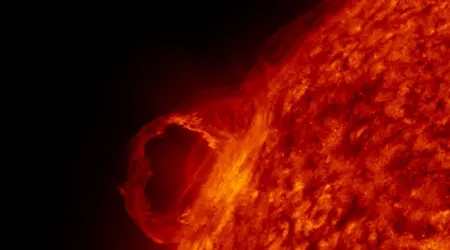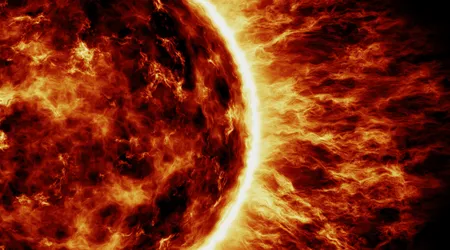Solar Flares: How These Explosive Events Impact Earth

These phenomena, known as solar flares, are among the most dramatic events in our cosmic neighborhood.
Anúncios
But what exactly are they, and how do they affect our planet?
In this article, we’ll explore the science behind these explosive occurrences, their potential impacts on Earth, and why understanding them is crucial for our increasingly technology-dependent world.
What Are Solar Flares?
Solar flares are sudden, intense eruptions of electromagnetic radiation from the Sun’s surface.
They occur when magnetic energy built up in the solar atmosphere is released, often near sunspots—dark, cooler areas on the Sun caused by intense magnetic activity.
These explosions can last from minutes to hours and release energy equivalent to millions of hydrogen bombs.
The classification of solar flares depends on their strength.
Scientists categorize them into three groups: C-class (weak), M-class (moderate), and X-class (the most powerful).
For context, an X-class flare can produce as much energy as a billion megatons of TNT.
The study of solar flares is critical for understanding the Sun’s behavior and its impact on the solar system.
Researchers continuously monitor solar activity to improve their predictive models and enhance our preparedness for these explosive events.
The Sun-Earth Connection: How Flares Reach Us
While the Sun is 93 million miles away, its activity doesn’t stay confined to its surface.
Solar flares often accompany coronal mass ejections (CMEs), which are massive bursts of solar wind and magnetic fields rising above the solar corona.
When these charged particles travel toward Earth, they can interact with our planet’s magnetosphere, the protective magnetic field surrounding us.
This interaction can lead to geomagnetic storms, which, while invisible to the naked eye, have tangible effects on our technology and environment.
For instance, a study by the National Oceanic and Atmospheric Administration (NOAA) found that a single X-class flare in 2003 caused radio blackouts and disrupted satellite communications worldwide.
Understanding the dynamics of these interactions is essential for predicting and mitigating their effects on our infrastructure.
Moreover, ongoing research into the Sun’s activity helps scientists develop better models for space weather forecasting, which is vital for protecting satellites and power grids.
+ The Origin of the Kuiper Belt: Exploring the Edge of the Solar System
Impact of Solar Flares on Earth
The effects of solar flares on Earth are multifaceted, ranging from awe-inspiring auroras to potentially catastrophic disruptions.
Let’s break down their impacts into three key areas:
1. Technology and Communication
Our modern world relies heavily on satellites, GPS systems, and radio communications—all of which are vulnerable to solar activity.
High-energy particles from solar flares can interfere with satellite electronics, disrupt radio signals, and even damage power grids.
For example, the infamous 1989 geomagnetic storm caused by a series of flares left millions in Quebec without electricity for hours.
The economic implications of such disruptions can be staggering, affecting everything from transportation to banking systems.
As our reliance on technology increases, the need for robust protective measures against solar activity becomes ever more critical.
2. Auroras: Nature’s Light Show
Not all impacts are negative.
When charged particles from the Sun collide with Earth’s atmosphere, they create stunning auroras.
These colorful displays, often seen near the polar regions, are a direct result of solar flares and CMEs.
The stronger the flare, the farther south these lights can be observed.
Auroras serve as a reminder of the dynamic relationship between the Earth and the Sun, captivating observers with their beauty.
They also provide scientists with valuable data about the Earth’s magnetic field and atmospheric conditions.

3. Human Health and Space Exploration
While Earth’s atmosphere and magnetosphere shield us from most harmful radiation, astronauts in space are at greater risk.
Prolonged exposure to high-energy particles from solar flares can increase the risk of radiation sickness and long-term health issues.
This makes monitoring solar activity critical for the safety of space missions.
As we venture further into space and plan missions to Mars and beyond, understanding the risks posed by solar flares becomes increasingly important.
Developing effective shielding and safety protocols for astronauts will be essential to ensure their health during extended missions.
The Science Behind Predicting Solar Flares
Predicting solar flares is no easy task.
Scientists use a combination of ground-based observatories and space-based instruments, like NASA’s Solar Dynamics Observatory (SDO), to monitor the Sun’s activity.
By analyzing sunspots, magnetic fields, and radiation levels, researchers can forecast potential flares with increasing accuracy.
However, predicting the exact timing and intensity remains challenging.
As our understanding of the Sun’s behavior improves, so does our ability to mitigate the risks associated with these explosive events.
Technological advancements in data analysis and machine learning are enhancing predictive capabilities, allowing scientists to identify patterns and trends in solar activity.
With these tools, we can better prepare for solar events and minimize their impact on our daily lives.
Historical Solar Flares: Lessons from the Past
History offers valuable insights into the potential dangers of solar flares.
One of the most notable events occurred in 1859, known as the Carrington Event.
This massive geomagnetic storm caused telegraph systems to fail, with operators reporting sparks and fires.
If a similar event occurred today, the consequences could be far more severe, given our reliance on technology.
More recently, a 2012 solar storm narrowly missed Earth.
Scientists estimate that if it had hit, it could have caused trillions of dollars in damage to global infrastructure.
These historical events serve as a stark reminder of the Sun’s power and the vulnerabilities of our technological systems.
As we learn from past incidents, implementing better preparedness and response strategies will be crucial for minimizing future risks.
++ Formation of the Solar System: From Nebula to Current Structure
Preparing for the Next Big Flare
As our dependence on technology grows, so does the need to prepare for the next major solar flare.
Governments and organizations worldwide are taking steps to safeguard critical infrastructure.
For example, the European Space Agency’s (ESA) Lagrange mission aims to provide early warnings of solar activity, giving us more time to protect satellites and power grids.
Individuals can also take steps to prepare, such as having backup power sources and staying informed about space weather forecasts.
Public awareness campaigns can educate citizens on the potential impacts of solar flares and the importance of preparedness.
Additionally, investment in resilient infrastructure can help mitigate the effects of solar storms, ensuring that essential services remain operational during solar events.

The Future of Solar Flare Research
Advancements in technology are revolutionizing our understanding of solar flares.
Projects like NASA’s Parker Solar Probe, which “touches” the Sun, are providing unprecedented data on solar activity.
These missions not only enhance our ability to predict flares but also deepen our knowledge of the Sun’s role in the solar system.
As we continue to explore the cosmos, understanding solar flares will remain a priority.
These explosive events remind us of the Sun’s power and our vulnerability to its whims.
Further research will also focus on the long-term effects of solar activity on climate change and atmospheric conditions on Earth.
By unraveling these mysteries, we can better prepare for the future and appreciate the delicate balance of our solar system.
Tables: Key Facts About Solar Flares
| Category | Description |
|---|---|
| C-class Flares | Weak flares with minimal impact on Earth. |
| M-class Flares | Moderate flares that can cause brief radio blackouts. |
| X-class Flares | The most intense flares, capable of global disruptions. |
| Historical Events | Impact |
|---|---|
| Carrington Event (1859) | Caused telegraph systems to fail and sparked auroras visible as far south as the Caribbean. |
| 1989 Geomagnetic Storm | Left millions in Quebec without power for hours. |
| 2012 Near-Miss Storm | Could have caused trillions in damage if it had hit Earth. |
Conclusion
Solar flares are a testament to the Sun’s immense power and its profound influence on our planet.
While they can disrupt technology and pose risks to space exploration, they also create some of nature’s most breathtaking displays.
By studying these explosive events, we not only safeguard our way of life but also gain a deeper appreciation for the dynamic universe we inhabit.
As we look to the future, continued research and preparedness will be key to mitigating the impacts of solar flares.
After all, in the grand dance of the cosmos, understanding the steps is the first step to staying in rhythm.
With ongoing advancements in technology and research, we can enhance our resilience against solar activity and ensure a safer, more informed future.
The interplay between the Sun and Earth remains a fascinating area of study, promising new discoveries that may one day help us harness the Sun’s energy more effectively.
